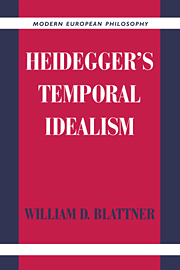Book contents
- Frontmatter
- Contents
- Acknowledgments
- A Note on Sources
- Introduction. Ontology, Phenomenology, and Temporality
- 1 Care as the Being of Dasein
- 2 Originary Temporality
- 3 World-Time and Time-Reckoning
- 4 The Ordinary Conception of Time and Disengaged
- 5 Heidegger's Temporal Idealism
- Conclusion. The Consequences of the Failure of Heidegger's Temporal Idealism
- Bibliography
- Index
5 - Heidegger's Temporal Idealism
Published online by Cambridge University Press: 05 June 2012
- Frontmatter
- Contents
- Acknowledgments
- A Note on Sources
- Introduction. Ontology, Phenomenology, and Temporality
- 1 Care as the Being of Dasein
- 2 Originary Temporality
- 3 World-Time and Time-Reckoning
- 4 The Ordinary Conception of Time and Disengaged
- 5 Heidegger's Temporal Idealism
- Conclusion. The Consequences of the Failure of Heidegger's Temporal Idealism
- Bibliography
- Index
Summary
Dasein, conceived in its extreme possibility of being, is time itself, not in time.
(BZ, p. 19)Not: time is; rather: Dasein temporalizes qua time its being. Time is not something that occurs somewhere externally as a framework for worldly occurrences; time is just as little something that rattles along somewhere in consciousness; rather, it is what makes possible being-ahead-of-itself-in-already-beingamidst, i.e., the being of care.
(PGZB, p. 442)time is not only and not primarily the schema for determining the ordering of changes, but rather, is actually Dasein itself.
(LFW, p. 205)So, when we have shown that the “time” that is accessible to Dasein's intelligibility [viz., world-time and ordinary time] is not originary and, what is more, that it arises out of authentic temporality. …
(S&Z, p. 329)first we are to understand that temporality, as ecstatic-horizonal, temporalizes something like world-time, which [in turn] constitutes the intratemporality of the available and occurrent.
(S&Z, p. 420)There is no nature-time, inasmuch as all time belongs essentially to Dasein.
(GP, p. 370)There is, in itself, the possibility that humans not be at all. There indeed was a time when humans were not. But strictly speaking, we cannot say: there was a time when humans were not. In every time, humans were and are and will be, because time only temporalizes itself insofar as humans are. […]
- Type
- Chapter
- Information
- Heidegger's Temporal Idealism , pp. 230 - 276Publisher: Cambridge University PressPrint publication year: 1999
- 1
- Cited by



